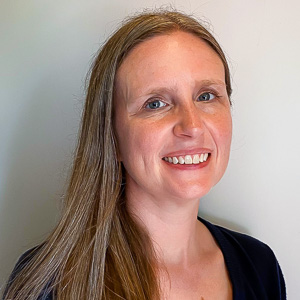Meet the Team
Rachel Clipp, Ph.D.
Medical Computing Expert
Kitware North Carolina
Carrboro, NC
Ph.D. in Biomedical Engineering
University of North Carolina at Chapel Hill and North Carolina State University
M.S. in Biomedical Engineering
University of North Carolina at Chapel Hill and North Carolina State University
B.S. in Mechanical Engineering
Clemson University
Rachel Clipp, Ph.D., is a technical leader on Kitware’s Medical Computing Team located in Carrboro, North Carolina. She conducts research in computational modeling and applies these solutions to biomedical problems. Rachel leads medical modeling and simulation projects at Kitware that involve the open source platforms Pulse Physiology Engine and iMSTK. She also leads computational modeling projects using Lattice Boltzmann Methods and artificial intelligence models that represent outcomes from high-fidelity physics-based models.
Under Rachel’s guidance, Pulse has been successfully incorporated in commercial and government-funded products and programs. The Pulse team has addressed the needs of the military for virtual medical simulation through collaborations with Exonicus to develop the Trauma Simulator and SimQuest and BioMojo to contribute to the Modeling and Simulation Training Architecture. They have also collaborated with academic and clinical institutions to test medical device algorithms with a closed-loop physiology management system. Recently, Kitware funded a project using Pulse to study the use of ventilators for multi-patient treatment in the early stages of the COVID-19 pandemic.
In addition to her technical work, Rachel is passionate about recruiting talented scientists and engineers to Kitware. She has been particularly involved in reaching out to women in science and engineering to increase diversity at Kitware. She participates in meetings and talks at universities to describe to students what it’s like to work in this industry and at Kitware.
Rachel is also very involved at Kitware. She is a member of the Events Committee at Kitware, where she helps plan social and health and wellness events for Kitware and assists with the organization of community giving for Kitware employees, and the Open Door Scholarship Committee, which aims to help increase diversity in the computer science industry.
Prior to joining Kitware, Rachel worked at Applied Research Associates as an R&D engineer between 2011 and 2016. She helped grow the medical modeling and simulation team, including leading proposal efforts and physiologic modeling for the BioGears Physiology Engine. During her time there, the BioGears team won several awards related to technical achievement, as well as publications from ARA and the government.
Rachel’s graduate work focused on the development of dynamic boundary conditions for use in finite element analysis and computational fluid dynamics. The boundary conditions developed were used to predict the effects of respiration on the pulmonary vasculature. She also developed a benchtop apparatus to perfuse and ventilate excised lamb lungs to collect hemodynamic and respiratory data for validation of the dynamic boundary conditions.
Rachel received her Ph.D. and master’s degree in biomedical engineering from the University of North Carolina at Chapel Hill and North Carolina State University. She received her bachelor’s degree in mechanical engineering from Clemson University.
Awards
Best Trauma Simulator presented by the SimVentors Showcase Serious Games and Virtual Environments Arcade and Showcase, 2020
Technical Achievement Honor presented by Applied Research Associates, 2015
Business Development Award presented by Applied Research Associates, 2013
Travel Award presented by the World Congress on Mathematical Modeling and Computational Simulation of Cardiovascular and Cardiopulmonary Dynamics, 2011
3rd Place Paper in Solid Mechanics, Design, and Rehabilitation presented by the ASME Summer Bioengineering Conference, 2007
R. Clipp and B. Steele, “Toward Determining a Dynamic Impedance Boundary Condition,” in Proceedings of the ASME Summer Bioengineering Conference, 2007. [URL]
Invited Talks & Media
Recent Developments in Kitware’s Pulse Physiology Engine, SIAM News Online, 2021
Professional Associations & Service
Member, The Institute of Electrical and Electronics Engineers (IEEE)
Member, Society of Women Engineers
Publications
- J. Webb, A. Bray, and R. Clipp, "Design and Implementation of a Generic Circuit Solver for Physiological Lumped-Parameter Modeling," in 2023 Annual Modeling and Simulation Conference (ANNSIM), 2023. [URL]
- A. Bray, R. Clipp, M. Qureshi, S. Mitran, and A. Enquobahrie, "gLBM: A GPU enabled Lattice Boltzmann Method Library," Journal of Open Source Software, vol. 7, no. 70, pp. 2555, Feb. 2022. [URL]
- S. Harrison, A. Bulysheva, B. Newman, M. Audette, R. Clipp, J. Webb, and M. Mitchum, "INTEGRATIVE PHYSIOLOGY-COUPLED PILOT-CENTERED FLIGHT SIMULATION," in ANNSIM ‘22, 2022. [URL]
- J. Webb, A. Bray, H. Scheirich, J. VanPelt, R. Clipp, J. Gerard, and S. Frembgen, "IMPLEMENTATION OF A DYNAMIC AND EXTENSIBLE MECHANICAL VENTILATOR MODEL FOR REAL-TIME PHYSIOLOGICAL SIMULATION," in ANNSIM’22, 2022. [URL]
- R. Clipp, A. Bray, B. Feiger, M. Qureshi, and J. Webb, "Recent Advances in the Pulse Physiology Engine," in SIAM Conference on Computational Science and Engineering, 2021. [URL]
- R. Clipp, A. Bray, and J. Webb, "Recent Improvements to Hemorrhage Modeling in Full-Body Physiology Simulation," in Technical Proceedings of the International Meeting on Simulation in Healthcare, 2021. [URL]
- M. Audettea, S. Harrison, M. Frazier, N. Watkins, A. Tinelli, P. Clark, K. Neale, J. Webb, A. Bray, A. Bulysheva, B. Newman, and R. Clipp, "Toward a Coupled Integrative Physiology-Flight-OBOGS Simulation for the Analysis and Mitigation of Hypoxic Events in Fighter Aircraft," in Military Health System Research Symposium, 2021.
- J. Webb, A. Bray, P. Asare, R. Clipp, Y. Mehta, S. Penupolu, and A. Patel, "Computational simulation to assess patient safety of uncompensated COVID-19 two-patient ventilator sharing using the Pulse Physiology Engine," PLoS ONE, Nov. 2020. [URL]
- B. Feiger, A. Wilson, S. Arikatla, R. Clipp, and A. Bray, "Simulation of arterial hemorrhage: Two-way coupling of a local high fidelity SPH model with a full body lumped parameter physiology model," APS Division of Fluid Dynamics, no. Fall 2020, pp. W09.012, 2020. [URL]
- J. Webb, A. Bray, and R. Clipp, "Parameterization of Respiratory Physiology and Pathophysiology for Real-Time Simulation," in 42nd Annual International Conference of the IEEE Engineering in Medicine and Biology Society (EMBC'20), 2020.
- R. Clipp, A. Bray, and J. Webb, "An Integrated Model for Hemorrhagic Shock and Fluid Resuscitation," in Military Health System Research Symposium (MHSRS), 2020.
- A. Bray, J. Webb, A. Enquobahrie, J. Vicory, J. Heneghan, R. Hubal, S. TerMaath, P. Asare, and R. Clipp, "Pulse Physiology Engine: an Open-Source Software Platform for Computational Modeling of Human Medical Simulation," SN Comprehensive Clinical Medicine, Mar. 2019. [URL]
- R. Clipp, J. Webb, R. Metoyer, and A. Bray, "Simulation of Asthma Attack and Inhaler Actuation using the Pulse Physiology Engine," in BMES Frontiers in Medical Devices, 2019. [URL]
- R. Clipp, J. Vicory, S. Horvath, S. Mitran, J. Kimbell, J. Rhee, and A. Enquobahrie, "An Interactive, Patient-Specific Virtual Surgical Planning System for Upper Airway Obstruction Treatments," in Proceedings of the Annual International Conference of the IEEE Engineering in Medicine and Biology Society, 2018. [URL]
- F. Gessa, P. Asare, A. Bray, R. Clipp, and M. Poler, "Towards A Test and Validation Framework for Closed-Loop Physiology Management Systems for Critical and Perioperative Care," in Medical Cyber Physical Systems Workshop, 2018.
- R. Clipp, A. Bray, R. Metoyer, M. Thames, and J. Webb, "Pharmacokinetic and pharmacodynamic modeling in BioGears," in Proceedings of the International Conference of the IEEE Engineering in Medicine and Biology Society, 2016. [URL]
- M. Thames, J. Webb, R. Clipp, J. Carter, Z. Swarm, R. Metoyer, A. Bray, and D. Byrd, "Dynamic response to heat gain and heat loss in the biogears engine," in Proceedings of the Medicine Meets Virtual Reality Conference, 2016.
- Z. Swarm, J. Webb, R. Clipp, J. Carter, M. Thames, and R. Metoyer, "Modeling renal behavior and control in biogears," in Proceedings of the Medicine Meets Virtual Reality Conference, 2016.
- R. Metoyer, B. Bergeron, R. Clipp, J. Webb, M. Thames, Z. Swarm, J. Carter, Y. Gebremichael, and J. Heneghan, "Multiscale Simulation of Insults and Interventions: The BioGears Showcase Scenarios," in Proceedings of the Medicine Meets Virtual Reality Conference, 2016.
- R. Clipp, A. Bray, R. Metoyer, M. Thames, and J. Webb, "Pharmacokinetic and pharmacodynamic modeling in biogears," in Proceedings of the Medicine Meets Virtual Reality Conference, 2016.
- R. Clipp, M. Thames, J. Webb, R. Metoyer, Z. Swarm, and J. Carter, "Integration of a baroreflex model into a whole body physiology engine," in Summer Biomechanics, Bioengineering, and Biotransport Conference, 2016.
- R. Metoyer, J. Carter, B. Bergeron, A. Baird, A. Bray, R. Clipp, M. Thames, and J. Webb, "A framework for multiscale physiology: towards individualized computer simulation," in Virtual Physiological Human Conference, 2016.
- Y. Gebremichael, R. Clipp, J. Webb, A. Bray, M. Thames, Z. Swarm, J. Carter, and J. Heneghan, "Integration of a spontaneous respiratory driver with blood gas feedback into biogears, an open-source, whole-body physiology model," in Summer Biomechanics, Bioengineering, and Biotransport Conference, 2015.
- A. Kennedy, R. Clipp, and D. Christensen, "First-in-human fractal methodology for modeling the hepatic arterial tree and tumor microvasculature for 90 Y-microsphere brachytherapy.," Journal of Clinical Oncology, vol. 32, no. 3_suppl, pp. 248-248, Jan. 2014. [URL]
- S. Snarski, J. Webb, C. Volpe, A. Menozzi, T. Sherrill, D. Hope, H. Towles, B. Young, C. Stutts, R. Steffes, J. Rittenhour, B. Fisk, R. Clipp, M. Bennett, B. Church, M. TerMaath, B. Kaminski, M. Forgione, J. Beighley, B. Judge, J. Mauger, A. Adams, and M. Larson, "Passive infrared projectile tracking and geolocation of low quadrant elevation (low qe) rockets and mortars: system development and test results," in Military Sensing Symposia Passive Sensors Conference, 2014.
- G. Scott and R. Clipp, "Humansim: A physiology engine for the simulation of anesthesia/anaphylaxis training," in Military Health System Research Symposium, 2012.
- R. Clipp and B. Steele, "An evaluation of dynamic outlet boundary conditions in a 1D fluid dynamics model," Mathematical Biosciences and Engineering, vol. 9, no. 1, pp. 61-74, Dec. 2011. [URL]
- R. Clipp, "Computational Models of the Pulmonary Vasculature Including the Dynamic Effects of Respiration," Ph.D. dissertation, University of North Carolina at Chapel Hill / North Carolina State University, 2010.
- R. Clipp and B. Steele, "Impedance Boundary Conditions for the Pulmonary Vasculature Including the Effects of Geometry, Compliance, and Respiration," IEEE Transactions on Biomedical Engineering, vol. 56, no. 3, pp. 862-870, Mar. 2009. [URL]
- R. Clipp and B. Steele, "Comparison of three types of dynamic boundary conditions," in Proceedings of the ASME Summer Bioengineering Conference, 2009. [URL]
- R. Clipp and B. Steele, "A Dynamic Boundary Condition for the Pulmonary Vasculature," in Proceedings of the ASME Summer Bioengineering Conference, 2008. [URL]
- R. Clipp and B. Steele, "Boundary conditons for the pulmonary vasculature," in Institue of Biological Engineering Annual Conference, 2008.
- R. Clipp and B. Steele, "Toward Determining a Dynamic Impedance Boundary Condition," in Proceedings of the ASME Summer Bioengineering Conference, 2007. Winner, 3rd Place Paper. [URL]
- R. Clipp, "Determination of Impedance Boundary Conditions for the Pulmonary Vasculature," M.S. thesis, University of North Carolina at Chapel Hill / North Carolina State University, 2007.
- R. Clipp and B. Steele, "Dynamic cardio-pulmonary impedance boundary conditions," in Biomedical Engineering Society Fall Conference, 2007.


